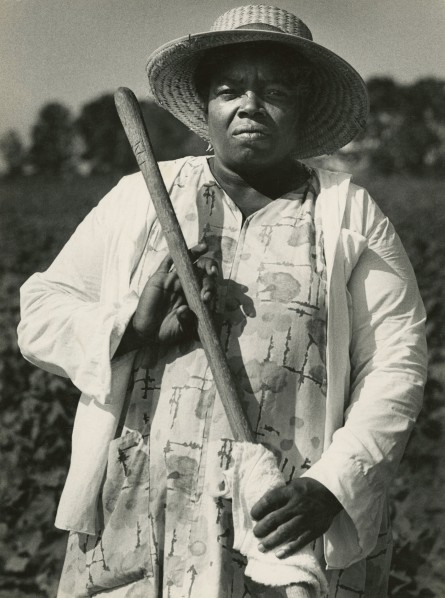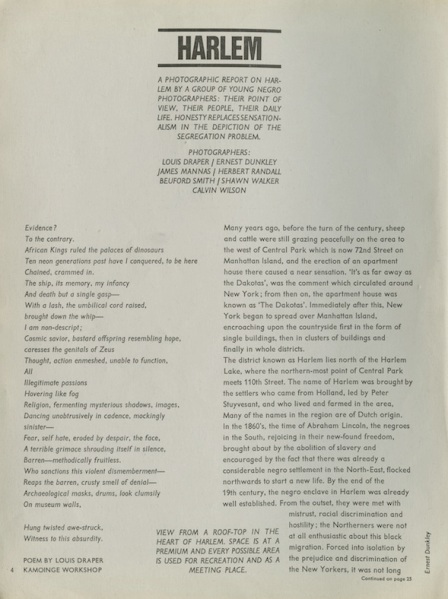
Girl and Cuba, 1968 (Philadelphia)

Girl and Cuba, 1968 (Philadelphia)


Fannie Lou Hamer was a political activist from Montgomery County, Mississippi. She spent much of her time working with the Student Nonviolent Coordinating Committee, a group of students who worked together against the racial injustice in Mississippi. In 1964 she went on to form the Mississippi Freedom Democratic Party. Hamer ran for Congress in 1965 but was not elected.
Fannie Lou Hamer was interviewed for the October 1971 issue of Essence magazine in an article titled “Fannie Lou Hamer Speaks Out” which featured images by Draper.
Click on the article images to enlarge


A few more Mississippi sharecropper images Draper made while visiting Civil Rights activist Fannie Lou Hamer.

Blindness, November 1961

The July, 1966 issue (no. 7) of the esteemed Camera Magazine featured a portfolio of images from the Kamoinge Workshop entitled, “Harlem.” This was a meaningful opportunity for Kamoinge, which is said to have been initiated by then-editor R.E. Martinez, presumably after coming through the brownstone gallery space in Harlem, which he is documented as having done.
Camera Magazine was an admired and acclaimed “international magazine for photography and cinematography” based in Switzerland that commenced in 1922 and lasted some 60 years. (It has apparently just resurfaced again in 2013, see here.) It was Camera’s 45th year when Kamoinge appeared in its pages.
The planning of the Camara feature was done with one editor, but as often happens in journalism, a switch happened mid-stream, and it was the new editor, Allan Porter, that finished managing the piece. Apparently Porter had a very different take on the photography being presented than had been previously discussed with Kamoinge members. The portfolio, with an image by Louis Draper featured on the cover, was controversially (to Kamoinge) titled “Harlem” and subtitled: “A photographic report on Harlem by a group of young negro photographers: their point of view, their people, their daily life.”
The title and introductory commentary by Porter both framed the Kamoinge photographs, which included work by several members: Draper, Ernest Dunkley, James Mannas, Herbert Randall, Beuford Smith, Shawn Walker and Calvin Wilson, as being an exposé of the “real take” on the Harlem so often portrayed at the time in mainstream media. (Context: this was at the apex of the Civil Rights Movement in the United States, with the Harlem riot of 1964 in recent memory, and coincidentally Porter was Camera’s first American editor, giving him a presumably very specific American perception of the positioning of certain race relations perhaps unlikely to be shared by a non-American editor.)
An excerpt from Porter’s introduction which refers to all four portfolios of that Camera issue, including Kamoinge’s:
“All the photographers were personally involved in their subject, and their views are subjective for reasons of personal, racial, national or religious identification. This tends to make the visual portrayal less sensational reportage and more of a personal statement; above all, in each case the camera observes not as a curious outsider peeping through keyholes and pointing a finger, but as an insider, as part of the life it observes.”

pg. 18-19, Camera Magazine, July, 1966, Issue 7, photograph by Louis Draper
However, not all the included Kamoinge photographs were taken in Harlem. Many were taken across the US, and certainly not all, if any, of the photographers were living in Harlem at the time. Kamoinge had shortly operated out of the 139th Street brownstone but that was really the only concrete Harlem point of reference to be made.
Kamoinge members were apparently not pleased with the new positioning of their portfolio and wrote a post script that was published along with the photos:
“The Kamoinge Workshop is composed of black photographers whose involvement with their medium has brought them together to communicate the conditions they see and feel around them. The point of view expressed by these photographers is personal and individual, and their treatment of technical and aesthetic problems when dealing with aspects of the human condition is often radically different to the established approach. They come together to exchange ideas, to forge ahead with their contemporaries and to speak the truth as they see it through their work. The Kamoinge Workshop see Harlem as a state of mind, whether it exists in Watts in California, the south side of Chicago, Alabama, or New York.”
As for Draper’s contributions, along with the cover image entitled John Henry, he had two other images in the portfolio, one of a dapper black man on the street in the garment district of New York City, and another of a woman of color in a leopard-print dress crossing the street in what looks to be the Lower East Side. A powerful poem by Draper was also included to begin the set of images, as seen in the below scan.

In the book New Thoughts on the Black Arts Movement (ed. by Lisa Gail Collins and Margo Natalie Crawford), Erina Duganne devotes a chapter section on Kamoinge’s Camera Magazine portfolio entitled “Insiders and Outsiders: The Kamoinge Workshop’s ‘Harlem’ Portfolio.” (pages 190-204) Duganne interviewed Draper to discover that he did not personally know any of his subjects in the Harlem portfolio, and that with the John Henry image in particular (taken in the Lower East Side) he recalled feeling a sense of fear or concern that the man would be angry at being photographed. Duganne says “Draper’s anxiety with respect to his subjects undermines Porter’s assumption that the racial background of the members of Kamoinge necessarily predisposed them to intimately knowing the black subjects of their photographs.” (page 193) And later she puts it poignantly, “Rather than separate their art from their lived experiences, the members of Kamoinge used their photographs to explore the ways in which they informed and complicated one another.” (page 197)
Even with varying perceptions of the Camera Magazine portfolio, the piece gave a certain visibility and professional validation to the Kamoinge Workshop and its members, and was presumably the first case of a group of African-American photographers’ work being highlighted in the magazine for photographers all over the world to see.
Coming soon: Kamoinge, Part 4…the 1970s
 In May 1964, Edward Steichen invited Roy DeCarava, who in turn invited the Kamoinge group, to exhibit at Danbury Academy of Art, Connecticut in a fundraising exhibition sponsored by the local NAACP.
In May 1964, Edward Steichen invited Roy DeCarava, who in turn invited the Kamoinge group, to exhibit at Danbury Academy of Art, Connecticut in a fundraising exhibition sponsored by the local NAACP.
In early 1965 The Kamoinge Workshop rented space at 248 W. 139th Street in Harlem, known as the Market Place Gallery. There are several references to the “brownstone basement” that became the “Kamoinge gallery.”
Their first exhibition there was “Theme Black,” in April 1965, which “dealt with the Afro-American experience.” Each Kamoinge member chose three of their own photographs for the exhibition.
From June 6 – July 4, 1965 their exhibition, “The Negro Woman,” showed at the gallery space. Apparently this exhibition created friction both with the local community and within the Kamoinge Workshop itself. There is no explanation among Draper’s notes as to what exactly caused the conflict, but it was sufficient enough to a) cause the group to lose their brownstone gallery space and b) to cause DeCarava to resign over “workshop objectives.” Jimmie Manas then became interim director, but walked out in protest over the group’s “policy”. Ray Francis then became director. The big questions are what community nerve did the exhibition hit? What particular objectives and policies divided the group?

One of Draper’s photographs, the only documented photograph, from “The Negro Woman” exhibition.
The two exhibitions did gain the group a surge in visibility. Langston Hughes, Henri Cartier-Bresson, John Szarkowski of MOMA, George Ball the playwright, South African photojournalist Peter Magubane, and R.E. Martinez of Camera Magazine all came through the gallery space.
Also notably, photographer Beuford Smith joined Kamoinge in June 1965. (He resigned membership in October 1973, but became heavily involved again when the group re-congealed in the 1990s.)
The lack of designated gallery space did not hold back Kamoinge though. In 1966, they exhibited at the Countee Cullen Library (104 W. 136th Street) in a show called Perspective. “An exhibition of photographs by the Kamoinge Workshop and guests” ran July 20 – August 19, 1966. And they started working with Camera Magazine editor, R.E. Martinez, on a “Harlem” feature.
Up next: Kamoinge, Part 3: the Camera Magazine portfolio…

Fulton Art Fair, Brooklyn 1964-1965